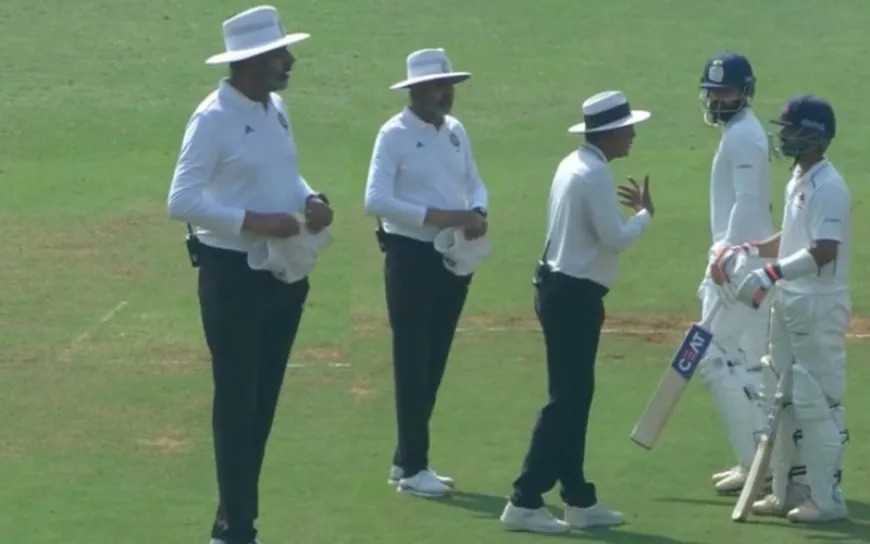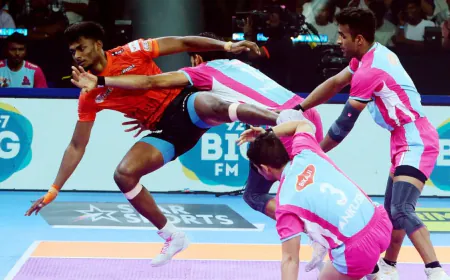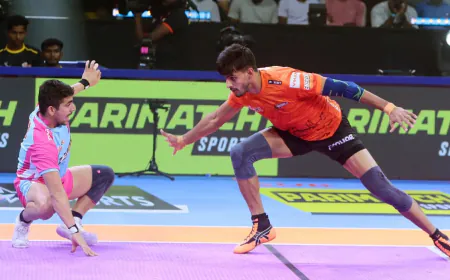Ranji Trophy Drama-The Shreyas Iyer Dismissal Controversy and the Struggle of Mumbai Against J&K
The Ranji Trophy saw high drama as Shreyas Iyer's contentious dismissal added tension to Mumbai's challenging match against Jammu & Kashmir. This article looks into the controversy, Mumbai's struggles, and the key moments that defined the game.

The Ranji Trophy match between Mumbai and Jammu & Kashmir, played at the Sharad Pawar Cricket Academy in Mumbai, has become the topic of much debate not only for high-stakes cricket but also because of a controversy related to one dismissal involving Mumbai's Shreyas Iyer. It was a day of heated arguments on Day 2 of the match, which saw the already competitive atmosphere of the domestic tournament increase further.
The Controversial Dismissal
However, it was an animated argument involving the batter Shreyas Iyer and J&K pacer Auqib Nabi Dar who got caught behind off a delivery. The catch was given by wicketkeeper Kanhaiya Wadhawan and upheld by the on-field umpire, who seemed to have agreed with the latter's decision over Iyer's vociferous protestations. He had argued at length over the dispute of whether the catch had been taken cleanly.
Ajinkya Rahane's batting partner, veteran of Mumbai, came forth immediately in his colleague's defense. He himself was at the non-striker's end and was arguing with the umpire's decision against his own bat. But the former did not budge from his stance and Iyer had to leave the field after having scored just 17 runs. This put a lot of pressure on Mumbai. It gave the much-needed debate on standards of umpiring and technology in domestic cricket.
Battle with the Bat at Mumbai
The whole drama of Iyer's dismissal is a symptom of a much larger problem in the match — Mumbai's struggles on a tricky green-top wicket. It was quite wrong to bat first on a bowler-friendly pitch. The first innings for Mumbai was knocked down for 120 runs; something that could never have been expected from the team, going by their performance in domestic cricket as one of the top teams.
Here, J&K capitalized on the batting woes of Mumbai and replied with 206 runs in the first innings in which they took a crucial lead. The visitors' bowling was disciplined and Auqib Nabi Dar exposed vulnerabilities in the batting order of Mumbai.
In the second innings of Mumbai, they really didn't muddle through. There were indeed flashes of form for the seniors, and among them was Rohit Sharma and Yashasvi Jaiswal; the two could just not get enough out of it to make some significant contribution toward the team cause. Sharma could score only 28, while Jaiswal could manage to score 26, keeping them on the back foot. But still, Mumbai managed to cross the 170 runs where every single run mattered as that game had reached the stage of the potential result.
It was not the only moment of tension within that game; both sides got hot tempered along with various emotional outbursts as the players contested some crucial moments. All this hullabaloo going on about Iyer's dismissal aside, the necessity of clear and consistent umpiring in the final stages of any match, be it with or without a high amount of stakes involved, has once again proved necessary. The Ranji Trophy was yet another target by the people and one of them has been that DRS does not exist.
Ajinkya Rahane's frustration, as visible on the field in that incident, spoke of the stakes for Mumbai. He is an experienced player and a leader; therefore, involvement at his level speaks to the gravity of the situation. Even as protests are a part of the game's competitive nature, it does leave questions about balance between respecting the umpire's decisions and doing justice on the field.
The Larger Consequences of the Match
This match is more than just a contest between two teams; it has reflected the challenge faced in Indian domestic cricket. For Mumbai, the decision to bat first on a green-top wicket seems to have proved costly, bringing home the significance of reading the pitch conditions appropriately. On the other hand, J&K's disciplined bowling attack has come out as something that reflects how cricket standards are changing in less-touted domestic teams.
The woes of Mumbai have also renewed debates on how seniors are able to influence the course of affairs in their teams. While players like Rahane and Sharma are stalwarts in their own right, their failure to stabilize the innings has become a bane for Mumbai during this match. The cavalier approach to crunch time may also spell doom for the team's position in the tournament.
The Way Forward
Now, as the game went into a tight situation, it has put Mumbai into a very testing position. The second innings has gone beyond 170, and now every run matters to set up a tough task for J&K. The game tested not only technical ability but also mental strength and their capacity to adapt themselves in the crucial moment.
The adverse controversy would work, to say the least, as a catalyst in further matches for Shreyas Iyer. As of now if Ajinkya Rahane goes on to successful enable Mumbai come out from this tough period, the centre stage would naturally again be drawn to his captaincy. The issue also points in the direction for the need of continuity in consistent umpiring and infusion of technology at domestic competitions levels.
A contest to remember
In such tournaments, matches with the ferocity of competition shown by this encounter between Mumbai and Jammu and Kashmir cannot fail to give exciting cricket battles as the tournament moves forward. One of them here is surely about Shreyas Iyer, Ajinkya Rahane protests, or indeed the many crises Mumbai are currently facing against an extremely hostile surface. Well, the takeaways from the match will possibly frame the response strategy of these teams in days ahead.
It is a game of uncertainties, moments of controversy and brilliance mixed together to create a riveting narrative. The drama unfolding in this match is testimony enough to the holding power of the Ranji Trophy as the spine of Indian cricket.




















































